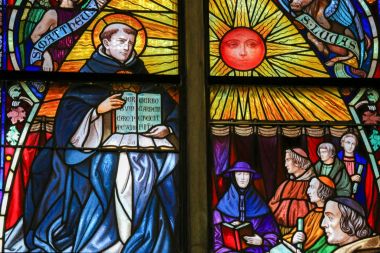
For the primary time in 750 years, the face of St. Thomas Aquinase was reconstructed utilizing forensic science and provided a view of a person whose educating for hundreds of years shaped Catholic considering. Together with this discovery, new analysis means that his demise was not attributable to sickness or poisoning, as was beforehand speculated, however was the results of traumatic mind damage.
Aquinas' affect on the Catholic doctrine is immense. His key work, Summa Theologica, stays one of the vital essential texts in Christian theology. He claimed that religion and motive weren’t in battle, however extra, and offered 5 logical “proof” for the existence of God. His ideas exceeded theology and reworked secular philosophy by combining morality with human nature and formed trendy ideas of freedom and authorities authority.
Cambridge dictionary philosophy describes Aquinas as “probably the most influential thinker of the medieval interval” and his teachings right now nonetheless assist the Christian religion.
A crew of scientists, led by forensic knowledgeable Cicero Moraes, used the partial stays of the Aquinase cranium to digital reconstruction of his face.
“At first we reconstructed the cranium from photographic and structural information,” Moraes defined in accordance with Each day Mail. “The cranium had no enamel or jaw, so we needed to mission these constructions primarily based on measurements taken from CT scans of the cranium of dwelling people.”
To make sure the accuracy, the crew used a technique referred to as anatomical deformation, during which the constructions of the cranium and faces of the reside donor had been modified to match the aquinas dimensions.
“Ultimately, we mixed all this information to create a primary bust and in addition create a shade model primarily based on the Holy iconography,” Moraes mentioned. The ultimate consequence, famous, was a “modest” face that displays the character of a big theologian.
For hundreds of years, historians have mentioned the reason for Aquinas's demise. Some attributed it to illnesses, others poisoning, and others even instructed assassination. A brand new research printed in world neurosurgery docs Gabriel Lebeau, Abdul -Rahman alkiswani, Paul Camarata and Theologian Daniel Mauro level to continual subdural hematoma – a situation during which blood collect between the mind and cranium after the pinnacle trauma.
Historic data describe how Aquinas on the way in which to Lyon's second recommendation in 1274 hit his head on a fallen tree whereas touring in Latin. Though he survived the preliminary influence and continued his journey, his situation deteriorated. At first he stopped to recuperate in Maenz, 45 miles southeast of Rome earlier than he received into the Abbey of Fossan, the place he ultimately died just a few weeks later.
The research explains: “Most continual subdural hematomas (CSDH) are preceded by some type of minor to center head damage. Crucial studying accounts of the final weeks of his life is a robust motive for CSDH – with classical medical historical past. Comparatively small head trauma, interval of readability after which gradual decline, as hematoma expands for a number of weeks. ”
Scientists say that Aquinas's “violent collision” with a tree on Through Latin meant the start of his demise.
They clarify that whereas some historic accounts point out illnesses, poisoning and even assassination, these theories don’t match present data.
As an alternative, the proof signifies a continual subdural hematoma, which is often attributable to a slight head damage, which might correspond to its preliminary readability interval adopted by a gradual decline in well being.
Thomas Aquinas, his life and his attainable demise stay for Western historical past college students, theology and philosophy and naturally Christians around the globe.
